

Happy New Year to all Readers! I look forward to 1990 and to continuing the service the Newsletter provides. I have also looked backwards to the beginning of ECN and hope you will find the enclosed index of all past technical articles helpful for quick reference.
The two main articles in this issue are concerned with software environments. The EVEREST environment was aimed specifically at device simulation. The PROCEDE environment shows the benefits of using a window environment to improve consistency of user interface.
Now that the two newsletters are circulated together. their distribution lists have been amalgamated, hopefully eradicating any duplicate labels. However, if you do receive two copies. please let us know.
At its meeting on 5 December 1989 the Computing Facilities Technical Advisory Group (CFTAG) decided to investigate how the new generation of visualisation software will perform in practice in solving real engineering problems. It agreed to invite bids to tender for a pilot development in advanced visualisation techniques for computational fluid dynamics (CFD).
The contract will be for a period of two years. It is intended to fund one person full time for that period to carry out the following tasks:
It should be noted that no computing equipment will be offered or funded with this contract. Costs associated with the acquisition of relevant software on existing hardware should be included within the bid. Bids should be sent to me at RAL by 28 February 1990, and will be considered by CFTAG and CFC in April. It is expected that the contract will start in early Summer 1990. Any queries concerning potential bids should also be made to me.
Engineering Applications; Is the Future Parallel? UMIST Manchester, 18-20 April 1990
The provisional programme is detailed on a separate insert to this newsletter. Early indication of interest in attending is advised, due to limited number of participants.
The numerical simulation of semiconductor devices in two dimensions is well-established for the design of advanced electronic components and processes. As device miniaturization approaches sub-micron feature sizes, three-dimensional effects are becoming important even for nominally standard planar devices. In many devices key physical effects occur at comers where three-dimensional models are the only way to obtain an accurate solution. The need to simulate the essentially three-dimensional effects of threshold shift for small channel devices, channel narrowing and the accumulation of carriers at the channel edge is growing. These effects make two-dimensional simulation codes inadequate for device-performance prediction.
EVEREST is a four-year project supported by the European Community under the European Strategic Program for Research in Information Technology (ESPRIT), that is investigating suitable algorithms for the analysis of semiconductor devices in three dimensions, and developing software implementing the most effective of those algorithms. Both Japanese and USA industries have already been very active in this area of three-dimensional modelling and it is appropriate that a joint European effort be focused on the solution of such problems.
The software under development within the project provides Europe with an important set of analysis tools which will ensure that the European semiconductor industry is well placed in the race to develop new device structures.
The partners participating in this project are drawn from some of the major industrial and academic research and development teams in Europe. They are listed below:
As can be seen, the list comprises four industrial partners, three large research laboratories and three universities. The Rutherford Appleton Laboratory is the overall project leader and prime contractor of the project.
Five main areas of activity have been identified and the project is divided into five workpackages, each with its own Workpackage Director. These five workpackages are:
The first four of these workpackages addresses one aspect of device modelling and the results produced are to be represented in the project code. The project will direct some 100 man-years toward developing solutions of the problems in simulating semiconductor devices.
Correct and reliable physical models are the key to establishing the validity and accuracy of numerical device simulation in two or three dimensions so as to account for the effects of mobility, heavy doping, etc. This workpackage is investigating the validity of the physical models being used within the project by the development of physical and analytical models, by parameter extraction to produce values to characterise the numerical models and by testing the research code against benchmark structures.
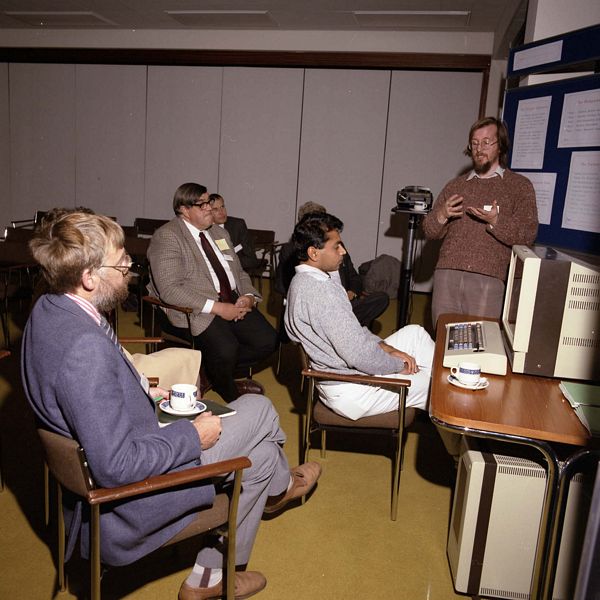
The objective of this workpackage is to investigate the different approaches to the discretisation of the conventional continuum device modelling equations. The extension of the standard Scharfetter-Gummel scheme into two and three dimensions are being considered as well as the use of fitted and mixed finite element methods. A second strand to this workpackage is the development of error estimates to be used to control the propagation of errors in the solution as adaptive mesh techniques are used.
As three-dimensional simulations are very complex in nature it is important to develop effective techniques to generate the discrete-model mesh automatically. There is considerable activity in developing strategies to produce meshes in three dimensions with the potential to be used adaptively. These techniques must then be coupled with the element selection algorithms to perform mesh refinement.
The most computationally intensive part of majority of the numerical simulations is the linear algebra. Within the project there is a continual effort in improving the solution procedures being used. Currently the two most successful methods being used within the project are Incomplete Choleski Conjugate Gradients (ICCG) and the Conjugate Gradient Squared Algorithm (CGS). Research is continuing to improve these solution techniques.
An important part of the project is the design and implementation of a complete simulation system using the best consistent set of the algorithms developed by the project. This part of the project will be described in detail in the next sections.
The design and implementation of a three-dimensional simulator is perhaps the most challenging task of the EVEREST Project, as it involves a cooperative effort between several partners and a clear definition of suitable interfaces between input preprocessor, mesh generator, numerical solver and display facilities.
In this section the software being developed within the EVEREST Project is described and, where appropriate, some details are given. The software consists of four main modules:
These elements of software are being developed at three sites as independent modules linked together by a common command parsing environment and data filing system.
These modules provide the project with a basic capability in geometric modelling and mesh generation. The geometric model is described in terms of a set of basic primitives: points, lines, surfaces and volumes. These can be used to construct a geometric model of most device structures. To enable the user to generate a geometric description a library of standard devices has been defined. This contains skeleton descriptions of a number of generic device structures.
The mesh generator then fills the model with tetrahedral elements and computes the subvolumes and subareas associated with the discretisation scheme.
This module allows the user to implant the silicon device with either uniform or Gaussian-type impurity profiles. The uniform profiles are applied to defined geometric volumes and the Gaussian profiles are applied through associated implantation windows and simulate predeposition, drive-in diffusion and ion implantation. These simple tools provide a sufficient set to enable us to test the analysis code. Although the specification of impurity profiles in terms of uniform and Gaussian distributions is a very poor approximation to reality they provide an effective source of profiles in the development phase of the project.
To supplement these simple generations an interface to external profiles has been provided. It is possible to take a one-dimensional profile obtained from a process simulator or by experiment and distribute this over a doping window. This provides the simulator with a source of more realistic impurity profiles.
The analysis module is a fully-coupled three-dimensional on-state and transient solver using the techniques developed in the rest of the project. It provides the user with complete control over problem specification and the generation of results.
The final module of the system and one of significant importance is the post-processor. This provides the user with the basic functionality to display the results of the analysis module. The module allows the user to display geometric, mesh and results data in a variety of ways: contour plotting and isometric projections, vector plots and one dimensional graphs along sections.
In this project the problems of investigating the most efficient algorithms for three-dimensional simulation of semiconductor devices are being tackled. A number of discretisation schemes are being pursued and the results compared to identify the most successful methods. These are being incorporated into the project research code and the results achieved in both off-state and on-state solutions are very encouraging.
Although a three-dimensional on-state and transient solver have been implemented much work remains to be done in extending the work to use fully adaptive mesh generating schemes. The advances made by the project so far show greater promise. At the end of the project European industry will have access to an advanced three-dimensional design tool that will help them to successfully compete in international markets.
Recent issues of the Newsletter have featured significant contributions referring to graphics packages and their impact, or lack of it, on software development for engineering applications. Almost exclusively, attention has focused on GINO/GKS/PHIGS/UNIRAS environments, with very little discussion about X windows and even less about PC based systems such as MS Windows.
Research undertaken previously at Leeds and now at Swansea is focused on creating graphical tools to enable research and industrial engineers to exploit the potential of modem computing hardware. Fundamentally, the objective of the work is to investigate ways of building computer integrated design environments to permit process engineers to execute the design process more effectively.
Process engineers use a variety of proprietary and in-house applications packages, most of which are essentially calculation procedures and not graphically orientated. One key to effective design is in ensuring that the results obtained from one application package are easily available to other packages.
Secondly, user interfaces are needed to permit the integrated environment to be exploited effectively. Loosely defined this means creating highly interactive software tools to allow process designers to do the following as easily as possible:
Taken as a whole an integrated design environment consists of three parts:
The workbench itself is an interactive graphical toolbox. The one described below is based on Microsoft Windows but has had several different forms in its evolution. It is not at all easy to explain in words and on paper just what constitutes the workbench and how it works. The following is intended to show how one small part of the workbench was conceived.
Process engineers, in academic institutions and industry, make extensive use of simulation packages. They tend to be based on software engineering principles established over twenty years ago. A particular problem is that they require the user to prepare off-line a long, complex, formatted data file with the aid of a 400-page manual. Much of the data is related to the way a chemical process is laid out (the flow sheet), and the properties (flowrates, temperatures, etc) of the bits of equipment that constitute the flow sheet. The data are a mixture of essentially pictorial information, as in the types of equipment constituting the process and the way in which these are connected, and pictorially associated data, in the sense that the operating conditions and component properties, for example, must be associated with the connections between the equipment items.
For complex processes there is a strong likelihood of error in the preparation of the data input files required by the simulator. The commonest source of errors arises in creating the topology section of the file. A natural way to overcome this problem is to make a drawing of the process flowsheet, on the back of an envelope or as a draughtsman style Process Flow Diagram (PFD), before attempting to enter the topology data into the input file.
In 1984 a project was set up to produce a highly interactive package for drawing PFDs on a graphics display, with the secondary but more important objective of automatically generating the topology in a form required by the simulation package. FORTRAN supported by a GINO library on a PRIME multi-user mini (MUM) constituted the development environment. Emphasis was placed on developing a mouse driven menu selection system.
Subsequently, graphical kernel systems (GKS) entered the arena with its promise of standards (where did they go?) and better than GINO graphics facilities. We were faced with' the option of rewriting our entire PFD package, or leaving it intact and writing an interface with GKS. The result, called the Graphics Translator Package (GTP) consists of subroutines with names such as LINBY2, CHASIZ, CURSOR etc, containing FORTRAN code to convert GKS calls into the equivalent GINO calls. GTP is effectively a pseudo GINO library consisting of GKS routines.
In search of speed and better graphical functionality, we made in 1986 what with hindsight is now considered to be a sideways move and reengineered the PFD code for an early Apollo DN300 machine with a non-university (ie non-RAL) supported GKS library. This was a success but involved a great deal of work. The real benefit was that we became aware of the potential of true windows environments with concurrent processing capabilities.
Our introduction to Window Icon Mouse Pulldown menu (WIMP) environments coincided with the release of several highly animated computerised arcade games, the advent of What You See Is What You Get (WYSIWYG) word processors and a package called Microsoft Windows (and its associated software development kit (SDK)). As far as interactive graphics was concerned, everything pointed away from MUMs and towards workstations and PCs. In 1987 we began to develop graphical interfaces on PCs, in C with Microsoft Windows SDK and this led to PROCEDE.
The PROCEDE project aims to provide the engineer with a complete process design environment running on a desktop computer. Put simply, PROCEDE sets out to allow process engineers to perform the design process in a natural way, almost as if the computer did not exist. The emphasis is on moving the focus of attention away from the calculation procedures contained in the applications packages and towards the design process itself. This is where creativity on the part of the engineers involved in the design process has the most significant impact on the cost, optimisation, operability, construction and commissioning of the as-built plant.
Windows applications all present the same graphical interface to the user since the windows, menus and scroll bars are all drawn by the Windows environment, rather than by an individual application. Microsoft's Application Style Guide details the way in which a Windows program should respond to the user. This means that anyone familiar with one Windows can use any other Windows application with the minimum of tuition. There are obvious benefits of this approach, both to the programmer and to the user, since little programming time is spent on the overall 'look-and-feel' of the program and thus the programmer can concentrate on application functionality.
Windows has a number of built-in functions which make the development of co-operative applications (such as those forming PROCEDE) less difficult The primary one is multitasking - an engineer can use the screen of the computer as a workbench with calculator, notepad, draughting package and simulator all available at the same time. An intensive numerical task (such as a rigorous design) can be initiated and then the application shrunk to an icon with the calculations taking place in the background whilst the engineer uses a different package.
Dialogue Boxes are the main method of data input ASCII files communicate with external applications. Files can be transferred from the PC to a multi-user machine where a proprietary simulator resides, and with the PC connected to the host in emulation mode the simulation is executed. The results from the simulation are then displayed on the PC.
These images are taken from a PROCEDE case study. I believe they are self evident and need few words of explanation. Each figure is a snapshot of the screen of a PC with Enhanced Graphics Adaptor (EGA) display, captured by the Snap facility within Windows. They show the steps in the design process that were followed with PROCEDE. They show tools for drawing, data input, data transfer, report writing, word processing and integration.
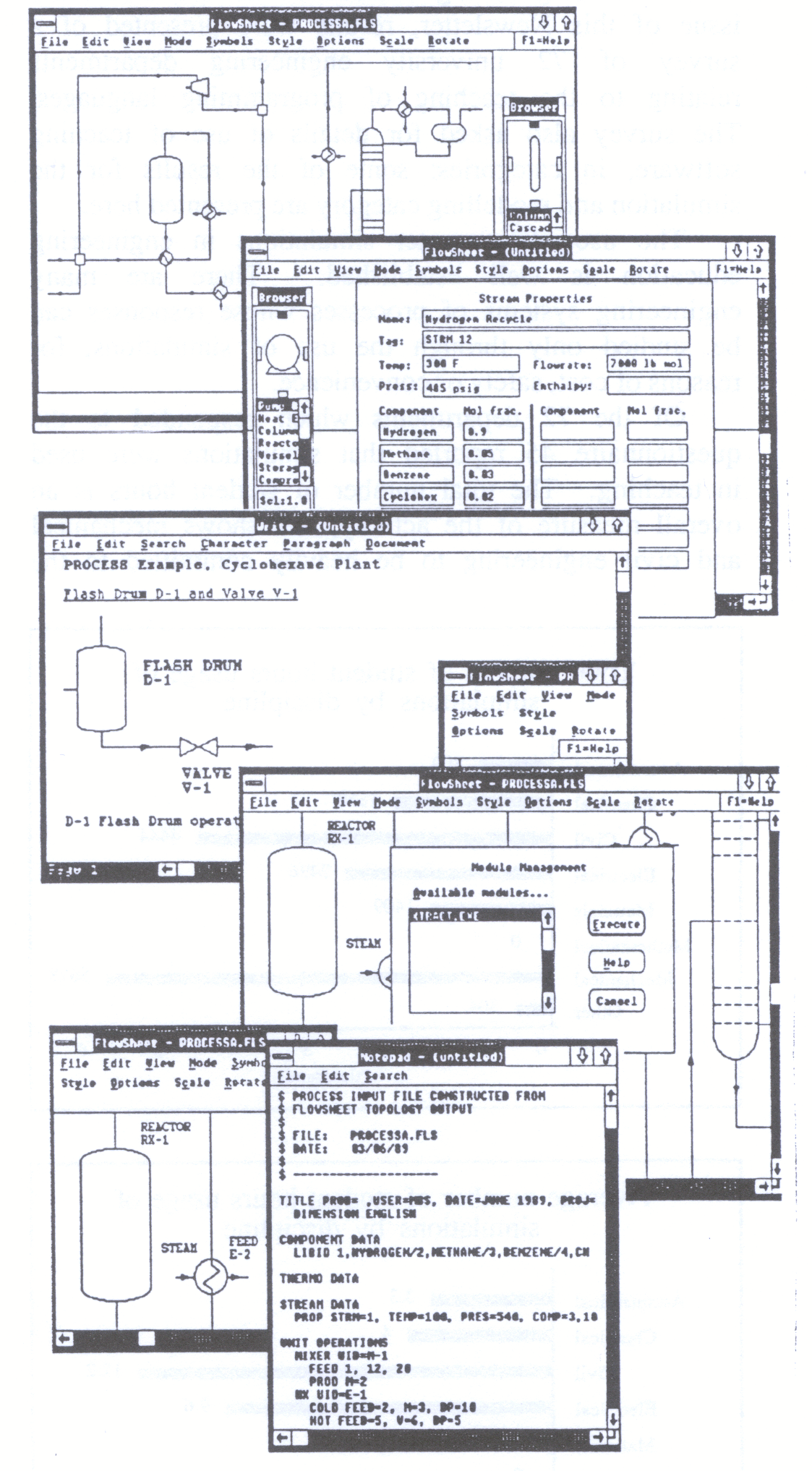
Editor's Note: The reduction of the examples above from their original size does not allow the text to be read clearly, and therefore these examples are shown only to illustrate the use of data in the case study.
As reported earlier In the Newsletter, the Computers in Teaching Initiative (CTI) Centre for Engineering was established to provide a service to engineering departments around the country. One of its objectives is to establish and maintain an information database containing details of software for use in engineering education. In the December issue of this Newsletter, results were presented of a survey of 72 university engineering departments relating to the teaching of programming languages. The survey also asked for details of use of teaching software, in categories: some of the results for the simulation and modelling category are presented here.
The use of computer simulations in engineering education is well established. There arc many engineering systems of processes whose responses can be studied only through the use of simulations, for reasons of cost, safety or convenience.
Of the 72 departments which responded to the questionnaire 45 reported that simulations were used in teaching. The total number of student hours is an overall measure of the activity, and shows mechanical and civil engineering to be heavily committed to the use of simulations; the average hours per student reflects the greater total number of mechanical engineering students in the reporting departments and reveals a more intensive use by civil engineers.
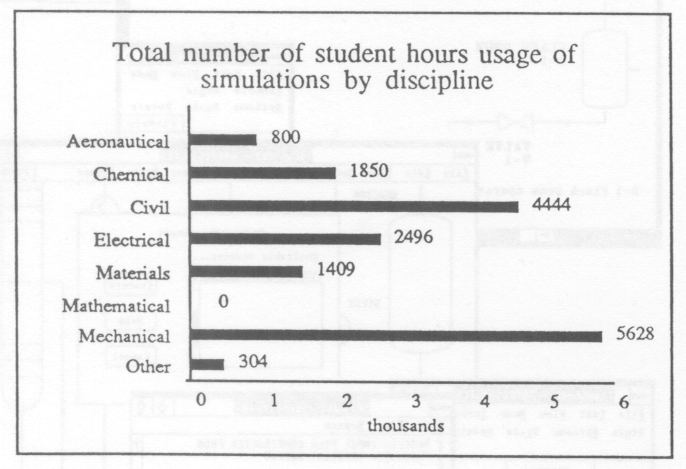
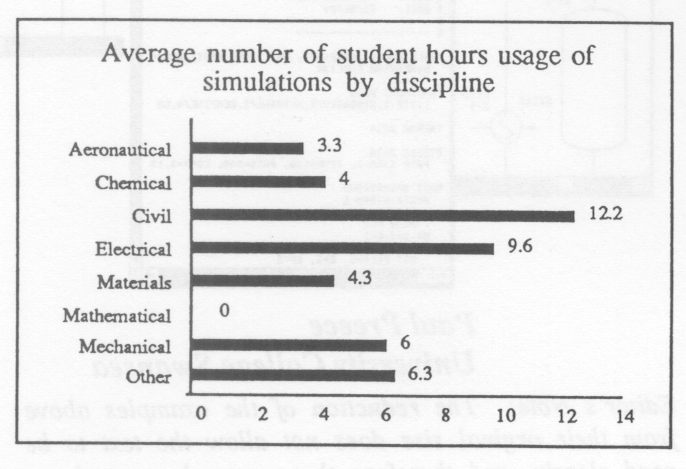
The survey asked for details of software used in teaching in two categories: in-house software developed within a department or institution and bought-in software which originated elsewhere. It should be noted that the 47 in-house packages can be assumed to be distinct and different but that is not true of the 89 bought-in packages, since the same package may be acquired by several departments.
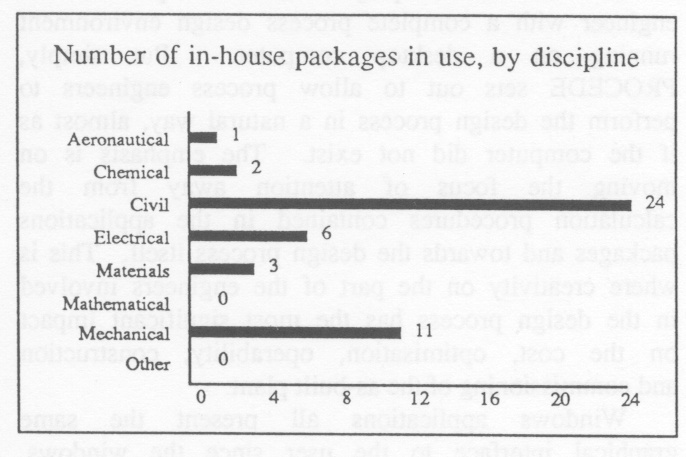
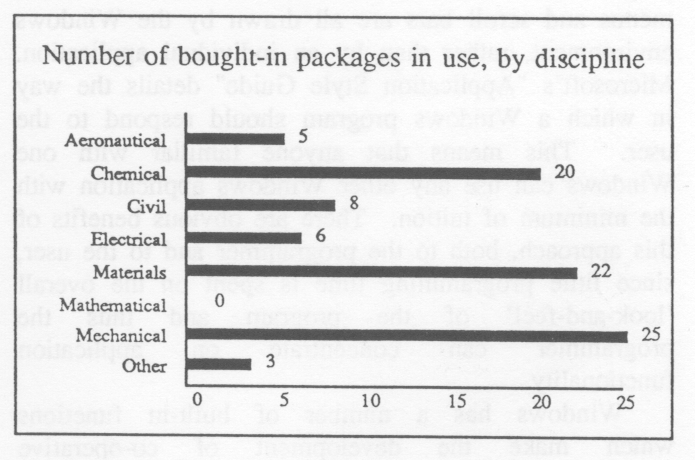
Thirteen packages are reported as being used in more than one department; the most frequently reported is in use in four departments. In total there are just over 90 different package names in the list.
Where in-house software has been reported, the CTI Centre is following up to obtain details of content and availability. If appropriate, this information will be added to the software catalogue which is being assembled.
As part of the EASE programme of work at RAL, we are evaluating toolkits available for the X window system, with the objective of at least making some recommendations in the area. We envisage a two-stage process, with the first stage being mostly a paper exercise of collecting information and, hopefully, discarding some of the toolkits at an early stage of the evaluation. The second stage would involve a more extensive evaluation, including design and implementation of some 'benchmark' exercises, principally aimed at finding out whether the toolkit in question will support a range of styles of interaction rather than prescribing one or a few. The list of toolkits we know about at present is as follows:
Are there any that we have missed?
We are in the process of developing a number of evaluation criteria, and so far have come up with the following list:
Again, any comments on the above would be welcome. Further, any comments on the toolkits themselves would be welcome - both positive and negative.
Please mail comments to me; a summary of the findings will be published in the uk.eng.apps newsgroup and this Newsletter. It may need to be edited to remove any commercially sensitive information, of course.
As part of the programme of work on X toolkits we also want to establish a UK X Toolkits Working Party, with representatives from a range of institutions. The aim of the working party will be to advise on and contribute to the assessment work on X toolkits for the communities. To be effective it will have to be a small group of people with relevant experience.
If you are interested in being on the working party or know someone who would be, please contact me.
The July edition of the Newsletter gave initial details of the support activity being established for TEX. The mechanisms for providing support have now been established and a framework for providing software is in the final stages of preparation.
Day-to-day support will be provided by means of electronic mail. The support line address is tex-support@uk.ac.umist. The mailbox is monitored regularly. The software to be provided is a carefully chosen subset from the TEX archive server at Aston, slightly modified to make installation on Unix based systems easier. Items that have been placed in the info-server catalogue so far are:
It is hoped to add previewers, both for X-windows and for Sun View, fairly shortly.
The first issue of the directory is now complete. There are fifty project entries in this issue. Each entry has a short project description, details of hardware and software used, a list of publications related to the project and a contact name and address. There are also two indexes so that information can be found easily. The directory is available free of charge. If you would like to receive a copy please contact us, preferably by email or in writing. Our email and postal addresses are given below. All who provided project information will receive a complimentary copy. Issue 2 will contain another sixty or so entries. It will be ready in the first quarter of 1990.
In Issues 8, 9 and 10 of the Engineering Computing Newsletter we announced that an AI in engineering bibliography was available for copying over JANET from the Artificial Intelligence Applications Institute (AIAI). The response has been good. Our log shows that there are around a hundred people who have copied it. Since then the bibliography has been extended and the second release is now ready. In this new release, the number of entries has increased from around three hundred to a thousand. The bibliography files, in Unix's REFER format, are available electronically. To receive a copy, send us your request by email and we will send you the files using your return email address.
The following short courses on AI are provided as part of the EASE programme and they are free of charge to suitable applicants who are working on projects funded by SERC grants. The course schedule in the first six months of 1990 is as follows:
These courses are very popular, so early booking is advised.
Super Computers/Workstations: review seminar, February
Computer Algebra for Engineers: seminar, March
Visualisation of Engineering Data: workshop, April
Engineering Applications using AI Techniques: seminar date to be arranged
The 1989-90 edition of the CHEST Directory of Software Discounts will be hitting the streets during the Christmas vacation period. The Directory contains details of over 700 commercially available software packages which are being offered to the UK Higher Education community at substantial discounts. Also included are articles on other national groups/services such as the NISS (National Information on Software and Services) Bulletin Board, the Software Catalogue, the National Public Domain Software Archive and so on.
If you saw the 1988 Directory we hope that you will be pleasantly surprised by the improvements we have made this year. Not only are there something like 70% more product entries but we have gone to great lengths to maintain some degree of consistency across all of the entries. You should find it much easier to use the new directory, despite its 570+ pages, and because we have recently double-checked the discounts being offered, you should find that the information about prices remains accurate for some time to come. We have deliberately rejected software products for which there is no special educational discount, so perhaps this will encourage companies to consider a pricing policy for HE in the future. CHEST needs to know when better prices than those given in the Directory are obtained; such information should be mailed to B.E.Barker@SWURCC.
Complimentary copies of the Directory are being distributed to the Computing Service, the Purchasing/Supplies Office, the Library and, most importantly, to every academic department in the UK Higher Education community. We are targeting the secretary to each department with this year's mailshot in the hope that the Directory will find the most appropriate home.
The catalogue now has some 1000 records of various types, and is rapidly growing in size. A much improved user interface is being designed, and should have been implemented before Christmas. Plans are currently being drawn up for the inclusion of the CHEST Directory and this should be available by mid-February.
Negotiations are well underway for the inclusion of records of the ESRC (Economic and Social Research Council) Data Archive and the VAX Applications Committee. Both activities are agreed in principle and are at the stage of establishing ways and means at a detailed level. The Catalogue is now registered with an NRS name - NISS.CAT
The NISS Bulletin Board service appears to be going from strength to strength! Although the underlying hardware has performed admirably during the last 12 months, while the average load has risen from 50 to 300 sessions per day, we are not sure how much longer the service will keep up with the demand. If you notice a significant deterioration in the speed of the service please tell us by using the MAIL option on NISSBB. We are currently investigating the financial feasibility of upgrading the hardware on which the Bulletin Board runs; our case will be strengthened if we have evidence that the current hardware can not do the job.
On the information side we can report that one or two of the Academic Discipline sections on NISSBB are beginning to take off: namely Chemistry (section N3), Modem Languages (P3), Physics (P6) and Pharmacy (P8).
To try NISSBB type: call niss or call 000062200000 from your PAD.
Finally, the NISS Team at Bath has been undergoing some traumatic changes during the Autumn with the loss of three of the four team members - was it something I said? The good news is that we have successfully recruited Catherine Humphrey as NISSBB Administrator and are currently recruiting the other team members; normality (whatever that is) should be restored in the New Year.
The 1990 Conference of the Association for Logic Programming - UK Branch (ALP-UK) will take place at the University of Bristol, beginning at lunchtime on 28 March and ending at about 5pm on 30 March.
The main themes of this meeting will be the interaction of basic research and potential applications, future directions in logic programming, and logic for information technology. The meeting will provide ample opportunities for the exchange of ideas with colleagues and research students. On Wednesday afternoon, there will be two tutorial sessions in parallel and the rest of the Conference will consist of single sessions. A number of invited speakers will give survey talks on subjects of topical interest in logic programming and the remainder of the Conference will be devoted to contributed papers.
IEE Vacation School: Software Engineering for Electronic Systems Designers 1-6 April 1990, University of Warwick. This School is intended primarily for engineers involved in the design of electronic systems containing embedded microprocessors and of other real-time systems which are dependent upon software for their functionality and performance.
7th International Symposium Automation and Robotics in Construction 5-7 June 1990, Bristol
Computer Simulation Conference (UKSC 90) 5-7 September 1990, University of Sussex.